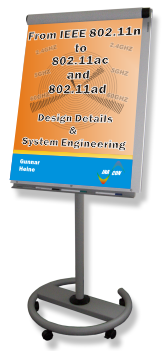 From IEEE 802.11n to 802.11ac and ad
From IEEE 802.11n to 802.11ac and ad
[2-day course, Euro 2,350.- (net) per participant]

Chapter 1: From 802.11-1999 to 802.11ac
The 802.11 Alphabet
Features and technology of 802.11-1999 to 802.11acBSS / ESS / AdHoc
Operation principles and problems of WiFi-networking, association to an APMultiple Access and Resource Sharing
CSMA-CA, DCF, PCF, detailed analysis and performance of CSMA-CA in real-life situationsQoS in WiFi
EDCA, HCCA, examples and logfile analysisPerformance of WiFi from 1999 to today
Throughput rates, latency, behavior under load conditions
Chapter 2: Introduction to 802.11ac
Feature Summary
From carrier aggregation to advanced MIMO, from LDPC to 256-QAMComparison with 802.11n
Performance, features and operationPerformance of 802.11ac under different conditions
Relevant parameters: Bandwidth, modulation, channel coding, GI, ...
Chapter 3: Detailed Analysis of seleted PHY- and MAC-Features
Channelization in 802.11ac
From 20 MHz to 160 MHz, primary channel selection, RTS/CTS operation with bandwidth indication, coexistence with 802.11a / 802.11n in 5 GHzSpectrum Requirements (Tx and Rx)
Spectrum Mask, sensitivity, options depending on channelizationSmart Antenna Operation in 802.11ac
STBC, SU-MIMO, MU-MIMO, Beamforming, Sounding and explicit compressed feedbackInherited (and deprecated) 802.11n Features
A-MPDU Operation in 802.11ac
PPDU-format
VHT-Sig A / VHT-Sig B / Preamble, ...
Chapter 4: Security in 802.11
Overview Security and Security Challenges
Attack and threat types, symmetric vs. asymmetric keys, authentication and encryption, integrity protectionSecurity in WiFi
WEP, WPA 1 and 2, 802.1X and RSNA, Key setup and generationAdvanced Options
Intro to EAP, operation of EAP-TLS, operation of EAP-AKA, generation of key material
Chapter 5: IEEE 802.11ad and its Playground
The “Playground” of 802.11ad
Applications, spectrum, history,Joined Operation of 802.11 (2.4 GHz), 802.11ac (5 GHz) and 802.11ad (60 GHZ)
DMG (Directional Multi Gigabit)
operation modes, packet structure and contents, modulation types, channel coding, single carrier vs. OFDM, Beamsteering operation for NLOS (non line of sight)
v1.000
Search:
More Info:
Schedule of this training courseOur Training-Catalog
GSM Training Courses
(E)GPRS Training Courses
3G Training Courses
Multimedia & TCP/IP Training Courses
SS7 Protocol Stack Training Courses
Transmission & Access Technologies Related Courses
Bootcamps
